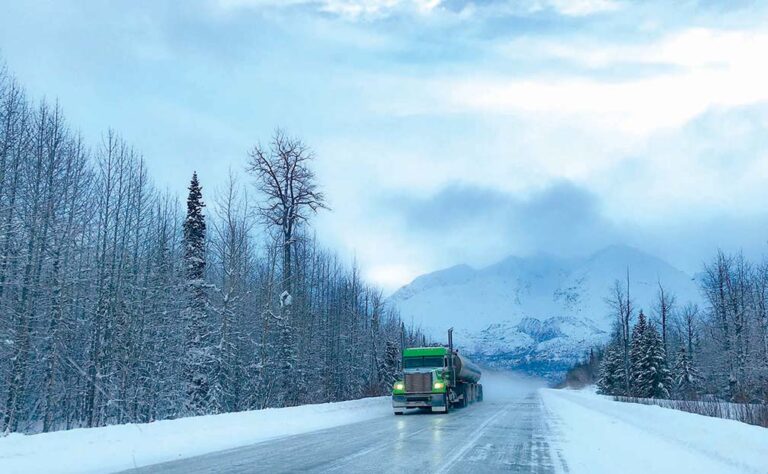The leaves are turning, and in some areas summer heat is giving way to crisp fall nights. The changing scenery is a welcome sight to many — but it’s also a warning that winter is rapidly approaching. In fact, in some parts of North America, it’s already here.
Experienced drivers know winter presents its own set of driving rules. Unfortunately, even experienced drivers can be surprised by that first snowstorm. Even worse, winter isn’t always heralded by falling snow; sometimes, it’s sleet or freezing rain.
It’s a good idea to review winter driving practices before encountering that first cold-weather hazard.
At the first hint that your truck’s road traction might be compromised, slow down. When you see vehicles that have run off the road or spun out, it’s a good indication there are patches of ice or snow on the road. The appearance of brake lights or emergency flashers on the road ahead could indicate a problem area, so be prepared to slow down or stop.
The pavement can appear dry and clear — until you round the next curve. In fall and early winter, the ground underneath the road surface still may still hold some heat from the summer sun, keeping the road surface warm enough to melt a light snow.
On the other hand, bridges and overpasses, without that warm ground underneath and with the wind blowing, are usually the first to freeze. Be prepared when approaching bridges and overpasses. If you’re suspicious about the road surface, hold the wheel steady, without braking or accelerating, as you cross.
Altitude changes mean temperature changes. More than a few drivers have discovered that raindrops at the bottom of a hill can turn into snowflakes near the top. If you’re driving in the mountains, be prepared for conditions to change quickly.
Changes can also occur as the sun sets. A day that’s been warm enough to keep the snow melted can quickly turn into a night cold enough to freeze that snowmelt into a treacherous sheet of ice.
Adding more distance between your front bumper and the vehicle ahead is always a good idea. During inclement weather, leaving a bit of extra following distance can give you more time to react to hazards ahead.
When roads are wet, and especially when the temperature is near freezing, test your brakes periodically. A gentle application while on a straight stretch of road will give you an idea of how your truck is reacting.
If you do have to stop on a slippery surface, remember that modern vehicles are equipped with anti-lock brakes. You shouldn’t need to pump the brakes, as the braking system does this for you at a rate much faster than you could ever achieve. If, however, your vehicle begins to skid, you may have to release the brakes and reapply pressure.
Some of the features of your vehicle that are designed to make life easier can become deadly when roads are slippery. Cruise control can’t sense that there is ice ahead and will do what it’s designed to do — maintain the speed it is set for. Unfortunately, that speed may be totally wrong for the road ahead.
Likewise, engine brakes can cause drive tires to break traction and skid, possibly causing a jackknife. Depending on the conditions, you may be able to set progressive engine brakes at a lower level if you’re descending a grade and need the braking power. If they aren’t needed, turn the engine brakes off.
It can be hard to tell when rain starts freezing. One of the easiest ways to tell is by looking for road spray from the tires of other vehicles. Wet roads create road spray. If there isn’t any spray, that “wet” road could be iced over.
Sometimes ice buildup on mirrors and brackets is visible. Obviously, if you see ice forming, you should assume it is also forming on the road surface. Keep an eye on the radio or CB antennas of other vehicles, too. Normally they will move with the wind stream, being pushed straight back. If they start moving wildly or in a circular motion, they may be coated with ice.
Visibility can also be an issue in winter. Blowing snow, road spray and windshields covered in dried ice-melting compounds that were applied to the road surface can make it more difficult to see. Keep windows and mirrors as clean as possible, and don’t forget to stock up on washer fluid.
On winter days when the sun is shining, the glare coming off snow-covered fields can be blinding. Because of the angle of the earth to the sun, the sun appears lower on the horizon, and sun visors are limited in how they can be positioned. A pair of quality sunglasses can improve your vision, increasing your safety while providing comfort for your eyes.
It’s a good idea to stay up to date on weather reports for the areas you’ll be driving into. There are a number of phone apps that provide this information, and some provide alerts when bad weather is expected. Online and phone resources can provide time-lapse video that projects the trajectory of storms, providing a better understanding of what’s ahead.
Some AM-FM radios or CB radios have weather “bands” that pick up weather reporting from the closest airport.
When possible, a review of expected weather should be part of your consideration before accepting a load. Weather will certainly impact travel time and may determine if you get there at all.
Finally, park your truck when conditions are unsafe. Driving on icy roads is always dangerous. Snow-covered roads aren’t quite as slippery and may be traveled safely at reduced speeds, but consider your trip plan. You may find it beneficial to take a break while you wait out the storm; it may be possible to travel at normal road speeds once you get back on the road.
Regardless of any time crunch you’re under, when it isn’t safe, park it. No load, no customer and no job are worth your life.
Careful trip planning, followed by following safe driving practices, will help you survive winter weather.
Cliff Abbott is an experienced commercial vehicle driver and owner-operator who still holds a CDL in his home state of Alabama. In nearly 40 years in trucking, he’s been an instructor and trainer and has managed safety and recruiting operations for several carriers. Having never lost his love of the road, Cliff has written a book and hundreds of songs and has been writing for The Trucker for more than a decade.









Like ” Regardless of any time crunch, when it isn’t safe , park it.”.